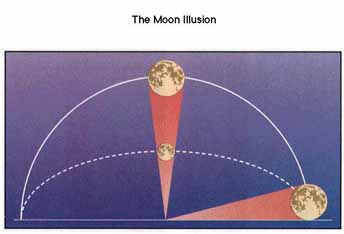In the New York Planetarium, scientific progress is presented as a transition from illusion to illusion, at least as far as astronomy is concerned

By Linda Scheiner, translated by Avi Blizovsky from AIR AND SPACE MAGAZINE, December 1993
Direct link to this page: https://www.hayadan.org.il/moonillusion.html
"Imagine yourself sitting on a beach in the shade of palm trees," says Washington National Air and Space Museum astronomer Jeff Chester: "In your hand you are holding a glass of one of the orange intoxicating drinks, with a paper umbrella sticking out on top. Later, when the moon is overhead, it appears much smaller. But it has nothing to do with the number of drinks you drank," he says. "This is a trick of the mind."
The Moon Illusion - the phenomenon whereby the Moon appears large when it is close to the horizon, is one of the illusions of the sky displayed in the Albert Einstein Planetarium show at the museum, under the title "A World of Illusions." The show will allow visitors to see the truth. "We can see that the apparent size is actually larger by two seconds of arc when the moon is in the center of the sky compared to its apparent size on the horizon" says Chester. During the rotation of the earth, when the star appears to climb in years, the viewer will actually get closer to it. Astronomers who measured the apparent size of the moon with a telescope and a micrometer, found that it is several microns larger in the Zenith compared to the horizon.
The idea behind the display is that "almost everything we see in the sky does not appear as it really is," explains planetarium director Jim Sharp. Every sunrise, for example, is an illusion, it is the movement of the earth and not the sun as it seems to us. As well as the illusion that on a clear night the stars twinkle. The show also covers observations of unknown and misunderstood illusions such as gravitational lensing - a recently discovered phenomenon whereby a heavy body deflects light coming from stars behind it. This can cause confusing things like splitting a galaxy into two and making it look like there are two galaxies where there is actually only one.
In addition to optical illusions there are also perceptual illusions. The show also demonstrates intellectual and conceptual illusions. There is also a demonstration that will dispel the old belief that everything in the universe has an order and that the chaos that sometimes manifests only originates from the failure of the human mind to understand the order that really exists there.
The concept of the ordered universe was put forward by the astronomers in ancient Babylon who discovered that if they tracked and recorded the position of the planets, they could predict their future position mathematically. The assumption remained firm until this century (the twentieth, for the authors of the original article). "We know that it is possible to predict the orbits of the planets for a few thousand years, but not for billions of years," says Sharp.
The entire history of astronomical discoveries is presented as a transition from one illusion to another. Sharp compares the astronomers to children in a magic show: "Every time the children thought they had discovered the trick, the magician would have another illusion to dazzle them."

4 תגובות
Cool:)